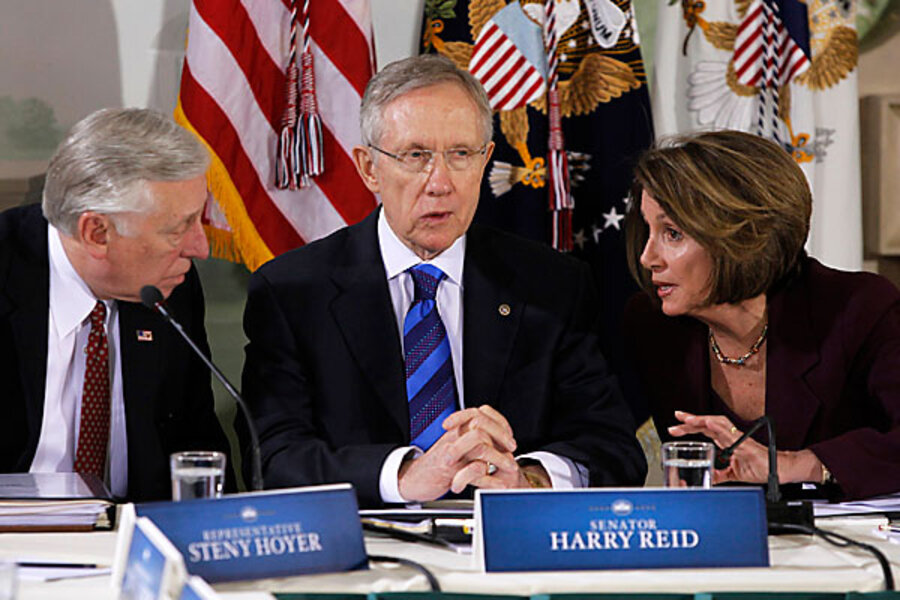Democrats seem ready to trade House seats for healthcare reform
Loading...
| Washington
With Monday’s resignation of Rep. Neil Abercrombie (D) of Hawaii to run for governor, Democrats are down to a 76-seat majority to move a historic healthcare reform bill through the House.
On paper, it’s a formidable edge, especially with House rules that give strong powers to the majority. But Speaker Nancy Pelosi struggled to win passage of a House-drafted bill last November, winning by just two votes.
The next vote – to muster a majority for a bill largely shaped in the Senate – could be even tougher, especially coming just months away from midterm elections expected to be punishing to Democrats. (For Monitor analysis of Democrats' current prospects in November, click here and here.)
In Pictures: Who are the Democratic House members retiring in 2010?
Democratic leaders see the healthcare vote as a defining moment, on a par with the passage of Medicare in 1965.
“They are prepared to do this even if it means losing control of the House,” says G. Terry Madonna, director of the Center for Politics and Public Affairs at Franklin & Marshall College in Lancaster, Pa. “That means they are prepared to go to anyone and everyone and promise them anything they want, including jobs after, if they get defeated, in order to get to 216 votes.”
On Wednesday, the president is expected to outline a plan to move forward on healthcare reform, including a controversial procedure to pass a bill by majority vote in the Senate.
For more than a year, the tipping point for healthcare reform has been the Senate. But with reconciliation, the heavy lifting shifts to the House, where Pelosi faces challenges consolidating support on both ends of her caucus. (For Monitor coverage of reconciliation, click here and here.)
Conservative Democrats are wary of “jamming” health care through the Congress using a process Republicans call a trick. (GOP congressional leaders used reconciliation to pass Bush tax cuts when they held the majority in 2001 and 2003.) Most of the Democrats voting no on last year represent districts that supported GOP nominee John McCain in the 2008 election.
In Pictures: Who are the Democratic House members retiring in 2010?
“Democrats from marginal districts are already in trouble. The question is, which ‘no’ votes will be willing to reconsider their votes and take on the flip-flopper charge,” says David Wasserman, who tracks House races for the Cook Political Report in Washington.
Some liberal Democrats say that if leaders opt to move reform through reconciliation, they must restore the public option to rebuild momentum for reform. Last week, Reps. Chellie Pingree (D) of Maine and Jared Polis (D) of Colorado announced that 120 Democrats signed a letter calling on leaders to pass the public option through reconciliation – a move the White House has opposed.
“Moderate Democrats in dangerous districts are in trouble if they just pass what they have now,” says Charles Chamberlain, political director for Democracy for America, citing their own polling in swing districts. “In districts where moderates are in trouble, over and over we find that, if you put public option in the bill, it’s suddenly popular again.”
If the compromise bill includes the Senate’s less restrictive language on the use of public funds to pay for abortion services, Pelosi could also lose up to a dozen members who previously voted yes.
“Unfortunately, the president's proposal encompasses the Senate language allowing public funding of abortion,” said Rep. Bart Stupak (D) of Michigan, in a statement. “The Senate language is a significant departure from current law and is unacceptable.”
If the Senate language is unchanged, he predicts that 10 to 12 Democrats who backed the House healthcare bill will vote against a compromise healthcare bill with the Senate, says Stupak spokeswoman Michelle Begnoche.
That prospect puts even more pressure on Pelosi to round up additional yes votes. Seven of the 39 Democrats who voted against healthcare reform come from districts that President Obama carried in the 2008 election, including Reps. John Adler of New Jersey, Brian Baird of Washington, and Dennis Kucinich of Ohio. So far, none have volunteered to change their votes to yes.
Three of those voting no last November have already announced their retirements and will not face voters. These include Reps. Bart Gordon and John Tanner of Tennessee, along with Congressman Baird. They, too, are potentially gettable votes.
Democratic leaders say they can find the votes they need. “In Round 1 in the House, we had members from so-called marginal districts voting for the House bill and some voting against it,” says Rep. Chris Van Hollen, who chairs the Democratic Congressional Campaign Committee. “Assuming we go forward with a reconciliation process, they will be listening very carefully to their constituents.”
“President Obama is going to have his wings clipped in November, quite possibly for the rest of his presidency,” says Larry Sabato, a political scientist at the University of Virginia. “If he wants to create a legacy, he must do it now. But Democrats must convince members of their caucus to sacrifice their seats.”
In Pictures: Who are the Democratic House members retiring in 2010?





